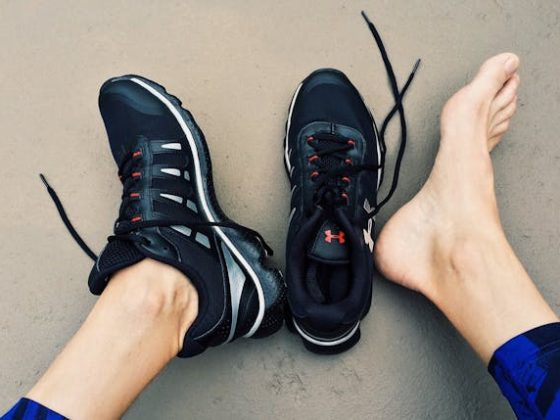Not every stroll needs to increase your heart rate, but if you want to enhance your walking regimen, incorporating more intense and aerobic walks can elevate your routine to another level like brisk walking. This article will tackle brisk walking tips, the key to boosting your average walking pace and overall health.
What is Brisk Walking?
Although walking offers health benefits, walking briskly provides additional advantages. Two research papers published in JAMA Internal Medicine and JAMA Neurology in 2022 found that individuals who engage in brisk walking for approximately thirty minutes daily have a notably decreased risk of heart disease, cancer, dementia, and mortality compared to those who walk slower.
Brisk walking is classified as a moderate-intensity workout and offers greater fitness benefits and reduced risk for health compared to walking at a leisurely pace. The walking speed required to be brisk depends on individual fitness levels.
In theory, brisk walking typically entails maintaining a speed of 3 miles per hour. It represents a more purposeful walking method geared towards enhancing fitness and health. Brisk walking is characterized by a pace that aligns with your metabolic rate, generally involving around 100 steps per minute, albeit this rate may vary slightly among individuals.
One study suggests for adults under 60, the minimum speed for moderate-intensity exercise is approximately 100 steps per minute. Translating to about 3 miles per hour or 4.8 kilometres per hour. However, individuals with higher fitness levels may not reach the moderate-intensity zone at this pace of 3 miles per hour (4.8 kilometres per hour).
To enter the moderate-intensity exercise zone, you may maintain a walking speed of 4 miles per hour (a 15-minute mile) or faster, equivalent to 6.4 kilometres per hour. Achieving a 15-minute mile walking pace would require walking at 4 to 5 miles per hour (6.4 to 8 kilometres per hour).
Achieving Moderate-Intensity Exercise
The pace required to reach moderate intensity varies from person to person. Instead of focusing solely on speed, focus on your exertion level, which can be gauged by monitoring your heart and breathing rates.
During brisk walking, you may find yourself breathing harder than usual yet still able to speak in complete sentences. Another indicator of moderate intensity is your heart rate, which should fall within 50% to 70% of your maximum heart rate, a figure that varies based on age.
Consider using tools such as heart rate monitors, fitness trackers, or apps to measure exertion accurately. These devices can display your target heart rate zone, helping you maintain an appropriate level of exertion during exercise. Alternatively, you can assess exertion using the Rating of Perceived Exertion (RPE) scale, which rates exertion on the scale ranges from 6 (no exertion) to 20 (maximum exertion). Factors like sweating and breathing rate can aid in determining your exertion level, even without equipment.
How Fast is a Brisk Walk?
Determining the speed of a brisk walk doesn’t always require high-tech gadgets. You can monitor your walking pace using various methods, regardless of where you walk.
Firstly, check your target heart rate. Calculate your maximum heart rate, typically estimated as 220 minus your age. For instance, if you’re 50, your heart rate is 170 beats per minute. During brisk walking, aim for a heart rate of 50% to 70% of your maximum (85-119 beats per minute for a 50-year-old). Utilize resources like the American Heart Association’s Maximum and Target Heart Rate by Age chart to guide you.
Periodically check your heart rate during your walk. Use a wearable tracker or manually measure your pulse by gently pressing your index and middle fingers over the artery on your wrist. Take your pulse for 30 seconds, then multiply the count by two. Another method is to monitor your steps per minute. Research suggests that maintaining a pace of around 100 steps per minute, equivalent to about 2.7 miles per hour, offers significant brisk walking benefits. A fitness tracker can help tally your steps and keep you on target.
Consider the talk test, a simple gauge of workout intensity. During moderate-intensity activities like brisk walking, you should be able to talk but not sing. Aim to limit conversation to just a few words for a more intense workout before needing to catch your breath.
Lastly, fitness trackers offer a convenient way to monitor your walking pace, distance, and more. These devices come in various forms, from wristbands to smartphone applications, enabling you to monitor your walking progress.
Benefits of Brisk Walking:
Brisk walking offers numerous health benefits, including:
· Enhanced metabolism:
Brisk walking optimizes energy utilization, aiding in the efficient digestion of food and burning excess calories. It contributes to maintaining healthy fat storage and promotes a higher metabolic rate.
· Improved mental health:
Taking a brisk walk serves as a refreshing break from daily routines, helping to clear the mind and alleviate accumulated negative emotions. Moderate physical activity, like brisk walking, can be mentally rejuvenating without being overly strenuous.
· Strengthened bones and joints:
Regular brisk walking enhances overall flexibility and fortifies bones and joints, reducing the risk of joint-related issues. Embracing an active lifestyle contributes to joint health and longevity.
· Weight management support:
Combining brisk walking with a balanced diet aids in weight management by fostering a healthy metabolism. It is an effective component of a holistic approach to maintaining a fit physique.
· Hormonal balance:
Brisk walking contributes to regulating stress hormones in the body while also triggering the release of endorphins, promoting feelings of positivity and contentment.
· Increased energy levels:
Engaging in brisk walking sustains and boosts energy levels, preventing fatigue and promoting vitality throughout the day. An active lifestyle fosters maintained energy levels, reducing the likelihood of easily becoming tired.

Techniques for Faster Walking: Brisk Walking Tips
Refining your walking technique can be beneficial if your typical walking speed falls short of brisk walking and you aim to pick up the pace. Enhancing posture, stride length, and arm movement often allows individuals to increase their walking speed. Flexible athletic footwear and clothing facilitating unrestricted movement can further boost your pace.
Initially, decelerate and focus on mastering the correct technique to increase your walking speed and eventually achieve a brisk pace. This technique encompasses walking posture, arm movement, foot placement, and stride length.
Walking Posture
Your walking posture is crucial in maintaining a moderate-intensity pace during your walks. Yet, if a medical condition impacts your posture and impedes your ability to walk upright,
it is important to consult a healthcare provider for advice for tailored guidance. They can evaluate your condition and ascertain if the suggested posture recommendations suit you.
Maintain a neutral posture without leaning forward or backwards during your walk. Strengthen your core by drawing your navel inward towards your spine, ensuring firmness without excessive tension in your abdominal muscles. Remember to breathe naturally and refrain from holding your breath, focusing about 20 feet ahead to prevent looking down.
Relax your jaw to alleviate tension in your neck, and let your shoulders fall naturally while slightly retracting them. Stand upright without arching your back, ensuring your head is up and your chin remains to keep your head aligned parallel to the ground to minimize strain on your neck and back. Keep your head level as you walk, allowing all movement to originate from the shoulders down.
Walking Arm Motion
Correct arm positioning and movement during walking can enhance your speed and intensity. Here are some guidelines to refine your arm motion for improved walking performance.
Maintain your arms bent at a 90-degree angle at the elbow. Avoid carrying objects while walking. Ensure your arms and elbows stay near your body, avoiding outward pointing. Sync your arm movement with your foot movement. As your right foot moves forward, your right arm should move back while your left arm moves forward. During the backswing, imagine reaching for an object in your back pocket. While maintaining a strong backswing, avoid excessive leaning. Focus on a mostly forward-and-back motion for your arms, preventing diagonal movements. Additionally, aim for a mostly level arm motion, avoiding reaching past your breastbone as your arm moves forward.
Walking Foot Motion
To enhance your walking speed, focus on refining your foot movement. However, consult a healthcare professional for personalized guidance if a medical condition affects your foot motion and impedes smooth walking. They can determine the applicability of the following tips or refer you to a physical or occupational therapist for tailored assistance.
Ensure you strike the ground with your heel and smoothly roll through each step, from heel to toe. Offer a strong push-off using the ball of your foot and toes as you complete your stride. If you notice that your foot slaps down instead of rolling through the step, it’s likely due to wearing stiff-soled shoes. Switch to flexible running shoes or gym shoes that offer flexibility in the forefoot.

Walking Stride
Focus on your natural walking stride rather than attempting to extend it. When you do lengthen your stride, ensure it’s behind you. Keep your back foot grounded for longer, then push off powerfully with your toes. Avoid overstriding when aiming for a faster pace. Ensure your forward foot strikes closer to your body, and be mindful of overextending your foot in front of your body.
Effective arm motion and a strong stride can elevate your heart rate to the moderate-intensity zone or even push it beyond into the vigorous zone. However, if you possess a high fitness level, simply walking may not raise your heart rate to the moderate-intensity zone. In such cases, transitioning to running or adopting a racewalking technique may be necessary.
Shorter strides may cause less irritation to lower body joints in certain individuals.
Conclusion:
Incorporate brisk walking practice into your regular walking routines, gradually increasing your time. Begin by focusing on your walking form and warming up with a leisurely 5-minute walk. Then, dedicate 10 minutes to practising your brisk walking technique before returning to an easy pace.
Gradually extend your brisk walking duration by 5 minutes each week as you become accustomed to the new technique. It’s common to experience muscle soreness or shin discomfort as you adjust your walking technique or footwear.
Once you can briskly walk for 15 to 30 minutes, utilize your new technique to enhance fitness and achieve the recommended 150 minutes of moderate-intensity weekly exercise.



